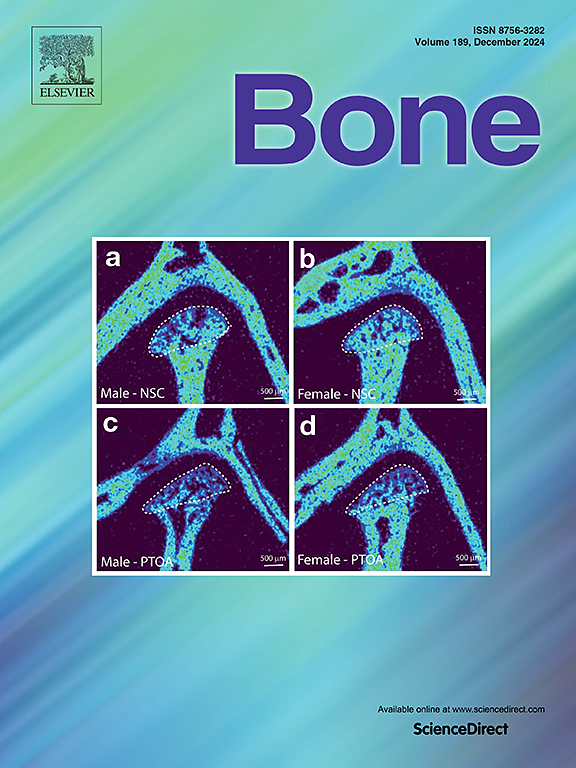1型和2型糖尿病对人股小梁骨组成、微结构和力学行为的影响
IF 3.6
2区 医学
Q2 ENDOCRINOLOGY & METABOLISM
引用次数: 0
摘要
1型糖尿病(T1D)和2型糖尿病(T2D)增加髋部骨折的风险超出了骨密度(BMD)的解释,可能是由于晚期糖基化终产物(AGEs)骨材料的改变和基质组成的改变。然而,关于糖尿病对人类小梁骨组成和力学行为的影响的数据有限。我们使用长期T1D(≥50岁;n = 24), T2D (n = 21)和非糖尿病控制(n = 21)。通过显微计算机断层扫描、力学测试(单轴压缩)、总荧光AGEs定量和拉曼光谱(基质组成)评估股骨头小梁骨。BMD和微结构测量在两组之间没有差异(p >;0.535)。与对照组相比,T1D小梁骨的AGE含量较高(+ 42%,p = 0.016),矿物质-基质比较低(- 12%,p = 0.048),结晶度较低(- 4%,p = 0.054),脯氨酸羟基化程度较高(+ 5%,p = 0.007),但力学行为无差异(p≥0.415)。T2D骨小梁的AGE也升高(+ 60%,p <;0.001)和改变的基质组成。与T1D不同,与对照组相比,T2D骨表现出更好的延展性和屈服后能量耗散,具有更大的极限应变(+ 36%,p = 0.008),屈服后应变(+ 62%,p = 0.075)和极限力韧性(+ 38%,p = 0.044)。本研究揭示了T1D和T2D对小梁骨基质组成的明显影响,尽管这些影响与单轴压缩载荷下力学性能的降低并不一致。本文章由计算机程序翻译,如有差异,请以英文原文为准。
Effect of type 1 and type 2 diabetes on human femoral trabecular bone composition, microarchitecture, and mechanical behavior
Both type 1 diabetes (T1D) and type 2 diabetes (T2D) increase hip fracture risk beyond what bone mineral density (BMD) explains, potentially due to changes in bone material from advanced glycation end-products (AGEs) and altered matrix composition. However, there are limited data regarding the impact of diabetes on human trabecular bone composition and mechanical behavior.
We assessed trabecular bone material behavior using cadaveric femoral specimens from older adults with long-duration T1D (≥50 years; n = 24), T2D (n = 21), and non-diabetic controls (n = 21). Femoral head trabecular bone was evaluated via micro-computed tomography, mechanical testing (uniaxial compression), total fluorescent AGEs quantification, and Raman spectroscopy (matrix composition).
BMD and microarchitecture measures did not differ between groups (p > 0.535). Compared to controls, T1D trabecular bone had higher AGE content (+42 %, p = 0.016), lower mineral-to-matrix ratio (−12 %, p = 0.048), trend toward lower crystallinity (−4 %, p = 0.054), and greater proline hydroxylation (+5 %, p = 0.007), but showed no differences in mechanical behavior (p ≥ 0.415). T2D trabecular bone also had elevated AGE (+60 %, p < 0.001) and altered matrix composition. Unlike T1D, T2D bone demonstrated improved ductility and post-yield energy dissipation versus control, with greater ultimate strain (+36 %, p = 0.008), post-yield strain (+62 %, p = 0.075), and toughness to ultimate force (+38 %, p = 0.044).
This study reveals distinct effects of T1D and T2D on trabecular bone matrix composition, although these effects did not coincide with reduced mechanical properties under uniaxial compression loading.
求助全文
通过发布文献求助,成功后即可免费获取论文全文。
去求助
来源期刊

Bone
医学-内分泌学与代谢
CiteScore
8.90
自引率
4.90%
发文量
264
审稿时长
30 days
期刊介绍:
BONE is an interdisciplinary forum for the rapid publication of original articles and reviews on basic, translational, and clinical aspects of bone and mineral metabolism. The Journal also encourages submissions related to interactions of bone with other organ systems, including cartilage, endocrine, muscle, fat, neural, vascular, gastrointestinal, hematopoietic, and immune systems. Particular attention is placed on the application of experimental studies to clinical practice.
 求助内容:
求助内容: 应助结果提醒方式:
应助结果提醒方式:


